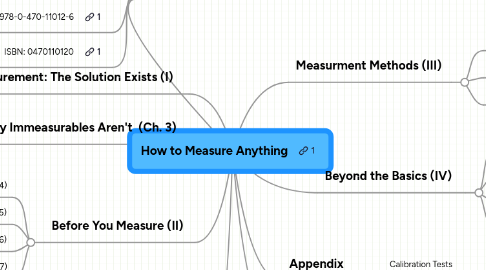
1. The Illusion of Intangibles: Why Immeasurables Aren't (Ch. 3)
1.1. Reasons people think something CAN'T be measured (don't understand...)
1.1.1. Concept
1.1.1.1. Measurement (defined): A set of observations that reduce uncertainty where the result is expressed as a quantity.
1.1.1.2. Reduction in uncertainty is sufficient (not elimination)
1.1.1.3. Some error is unavoidable but can be an improvement on prior knowledge
1.1.2. Object
1.1.2.1. Must determine the object of measurement.
1.1.2.2. "What do you mean by <fill in the blank>?"
1.1.2.3. Use Clarification Chain for tougher measures
1.1.2.3.1. If it matters at all, it is detectable/observable.
1.1.2.3.2. If it is detectable, it can be detected as an amount (or range of possible amounts).
1.1.2.3.3. If it can be detected as a range of possible amounts, it can be measured.
1.1.3. Method
1.1.3.1. Techniques for measuring things that may seem immeasurable
1.1.3.1.1. Measuring with very small random samples.
1.1.3.1.2. Measuring the population of things that you will never see all of.
1.1.3.1.3. Measuring when many other, even unknown, variables are involved.
1.1.3.1.4. Measuring the risk of rare events.
1.1.3.1.5. Measuring the value of art, free time, or reducing risk to your life by assessing how much people actually pay for these things.
1.1.3.2. Rule of five
1.1.3.2.1. 93% chance than the median of a population is between the smallest and largest values in any random sample of five from that population.
1.1.3.3. Useful assumptions
1.1.3.3.1. Your problem is not as unique as you think.
1.1.3.3.2. You have more data than you think.
1.1.3.3.3. You need less data thank you think.
1.1.3.3.4. There is a useful measurement that is much simpler than you think.
1.2. Common reasons why something SHOULDN'T be measured
1.2.1. Economic (too expensive)
1.2.1.1. Only a few things merit deliverate measurement efforts.
1.2.1.2. The rest have an information value at or near zero.
1.2.2. Usefulness and meaningfulness (anything can be proven with stats)
1.2.3. Ethical Objection (immoral to do it)
1.3. Toward a Universal Approach to Measurement
1.3.1. What are you trying to measure? What is the real meaning of the alleged "intangible"?
1.3.2. Why do you care -- what's the decision and where is the "threshold"?
1.3.3. How much do you know now -- what ranges or probablilities represent your uncertainty about this?
1.3.4. What is the value of the information? What are the consequences of being wrong and the chance of being wrong, and what, if any, measurement effort would be justified?
1.3.5. Within a cost justified by the information value, which observations would confirm or eliminate different possibilities? For each possible scenario, what is the simplest thing we should see if that scenario where true?
1.3.6. How do you conduct the measurement that accounts for various types of avoidable errors (again, where the cost is less than the value of the information)?
2. Measurement: The Solution Exists (I)
2.1. Intuitive Measurement Habit
2.1.1. Key points
2.1.1.1. Size up measurement problem and identify quick and simple observations that have revealing results
2.1.1.2. Wring out more info out of a few facts that can be confirmed rather than assuming the hard way is the only way
2.1.2. Fermin (Enrico) 1901-1954
2.1.2.1. Knack for intuitive, casual-sounding measurements
2.1.2.2. Estimated yield of atomic bomb blast using confetti
2.1.2.3. Fermi question - estimating by identfying what you DO know instead of what you don't
2.1.2.4. Not quite measurement since not based on new observations
2.1.2.5. Avoids quagmire that uncertainty is impenetrable and beyond analysis
2.1.3. Experiments
2.1.3.1. If it matters, it must have some observable consequences
2.1.3.2. Simple methods can be effective in scientific inquiry
2.1.3.3. Useful levels of experimentaion can happen on little budget
2.1.3.4. Could make it more complex but not necessary if asking a more basic question!
2.1.4. Examples
2.1.4.1. Estimate circumference of Earth by looking at shadow lengths
2.1.4.2. Piano tuners in Chicago (Fermi)
2.1.4.3. Therapeutic touch
2.1.4.4. Insurance sales example - Excellent!
2.1.4.4.1. Can Whichita Falls, TX support additional auto insurance salesman
2.1.4.4.2. ID the number of cars in city (62,172)
2.1.4.4.3. Ave annual premium in TX ($837)
2.1.4.4.4. Ave commission = 12%
2.1.4.4.5. Agencies in town 38
2.1.4.4.6. Commission per agency = $164K
2.1.4.4.7. Population falling
2.1.4.4.8. Market likely getting tight
2.1.5. Key Points
2.1.5.1. Fermi: "Yes, there are a lot of things you don't know, but what DO you know?" (p17)
2.1.5.2. Useful observations can tell you something you didn't know before...if you approach the topic with just a little more creativity and less defeatism. (p17)
2.1.5.3. Usually things that seem immeasureable in business reveal themselves to much simpler methods of observation.
2.1.5.4. Fermi's value to us is in how wer determine our current state of knowledge about a thing as a precursor to further measurement. (p17)
2.2. Intangibles and the Challenge
2.2.1. Example: IT Projects rejected because all benefits soft
2.2.1.1. Believed soft benefits couldn't be measured
2.2.1.2. Danger - don't overlook important projects because of supposed lack of ability to measure
2.2.2. Book purpose
2.2.2.1. Intangibles that appear to be completely intractable CAN be measured.
2.2.2.2. This measurement can be done in a way that is economically justified.
2.2.2.3. Focus: Measurements that are relevent to major decisions but don't seem to have obvious and practical measurement solutions.
2.2.2.4. No advance math training need - JUST aptitude for clearly defining problems.
2.2.3. Book web-site:
3. Before You Measure (II)
3.1. Clarifying the Measurement Problem (Ch. 4)
3.1.1. Premeasurement context
3.1.1.1. What decision is to be supported?
3.1.1.2. What is the "thing" to be measured?
3.1.1.3. How does the "thing" matter to the decision?
3.1.1.4. What's is known about it?
3.1.1.5. What is value to measuring further?
3.1.2. Language
3.1.2.1. Uncertainty
3.1.2.1.1. Existence of more than one posibility (p 46)
3.1.2.2. Risk
